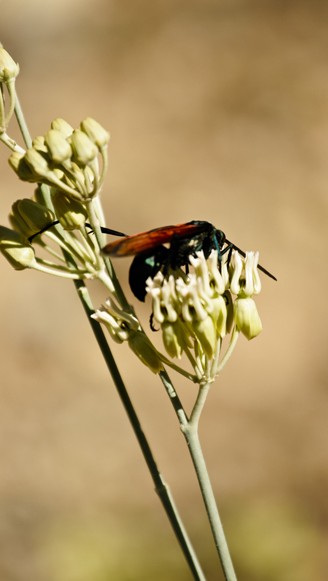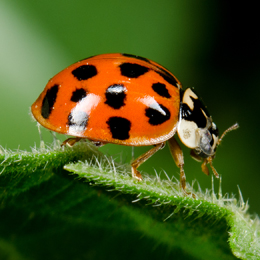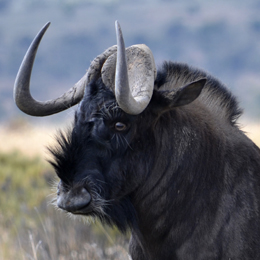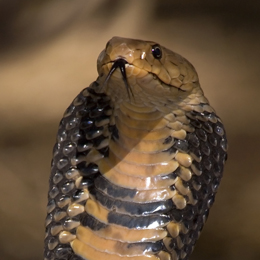Description
Tarantula hawks are a tribe of spider wasps belonging to the genera Pepsis and Hemipepsis. Each species of this tribe is specialized in the hunt on different spider species. They are widely known as tarantula hawks because of their capability of hunting down tarantulas. Standing at a length of 5 cm, the tarantula hawk can kill even the biggest of all tarantulas, including the goliath bird-eating Spider that can have a leg span of up to 30cm.
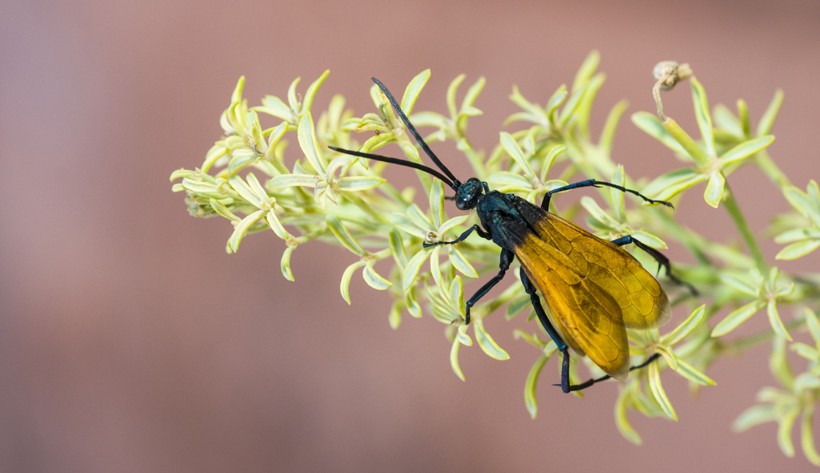
Tarantula hawk looking for nectar, Grand Canyon, Arizona
?
Image credits: NatalieJean/Shutterstock
Tarantula hawks detect chemical scents in its surroundings as they walk on forest grounds. The insect is also equipped with one centimeter long stingers. The tarantula hawk sting is described as one of the most painful stings of the insect world. Only the bullet ants of South and Central America are known to have a stronger sting than the tarantula hawk. However, the sting is not dangerous for humans and the pain will fade in a few minutes. The effects of the sting can last for up to a week. Generally, tarantula hawk species are blue-black in color with either rusty or black colored wings. There are a few factors that can be used to distinguish the male from the female tarantula hawk. While the antenna is straight in males, it is curved in females. In the abdomen region, males have seven articulating exoskeleton segments, in contrast to the female who has only six. Last but not least, male tarantulas have a lifespan of up to 2 months whereas the females live a little longer than that.
Habitat, Diet & Predators
There are 250-300 species of tarantula hawks worldwide. Over 250 species can be found in South America whereas 15 species occur in the United States (9 of them inhabit deserts). These wasps are highly adaptable, capable of surviving in a wide range of habitat settings. Tarantula hawks inhabit tropical rainforests, deserts, shrub- and grasslands. Simply, they are found wherever tarantulas appear.
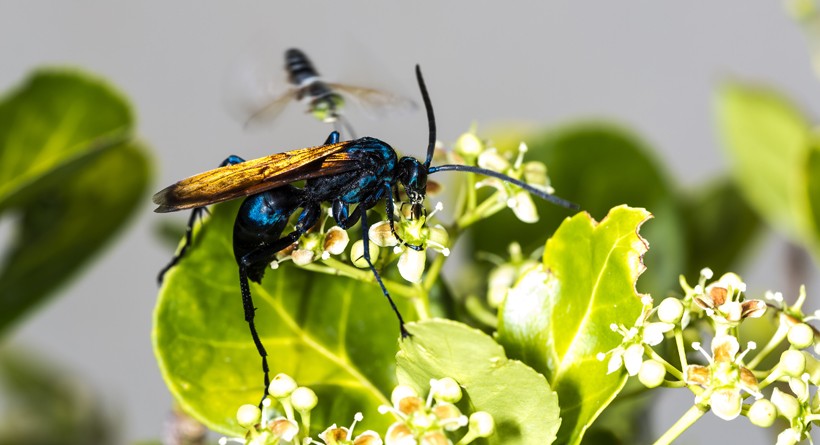
Adult tarantula hawks exclusively feed on nectar
?
Image credits: Elizabeth A.Cummings/Shutterstock
Surprisingly, the adult tarantula hawk feeds only on nectar. They do not hunt for food, but can be seen flying from plant to plant in search of nectar. They may consume fermented fruits whenever available; feeding on fermented fruits often gets them intoxicated to a point where they can hardly fly.
Tarantula hawks are diurnal. Within the summer months, they are most active during day time. The wasp avoids high temperatures and can be seen flying under the shade of plants and trees. The contrasting orange colored wings may be acting as a strong warning signal for other predators in its habitat; only a very few animals dare to hunt the tarantula hawk. Roadrunners are one of the few regular predators known to feed on tarantula hawks, but these wasps form a very small portion of this predators’ diet.
Reproduction and Lifecycle
Male tarantula hawks never hunt tarantulas. During the breeding season, males exhibit a behavior called hill-topping, where they defend small territories on tall treetops and wait for females to pass by. The male tarantula hawk can be quite territorial during this period. After mating, the female tarantula hawk is the one that goes for the tarantula hunt.
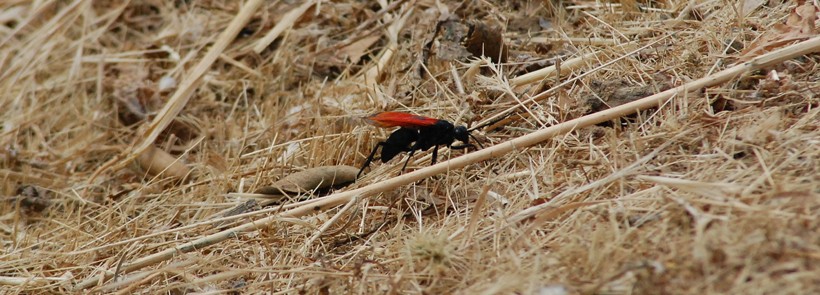
The female tarantula hawk is the one that goes for the tarantula hunt.
?
Image credits: Naaman Abreu/Shutterstock
In the wild, most predators hunt for food, but the female tarantula hawk doesn’t eat its prey. She hunts the victim down to serve as a living host for her larva. Over the years of evolution, female tarantula wasps seem to have specialized in the art of hunting tarantulas. She either finds a male tarantula looking for a female or spots one hiding in its burrow. To lure the spider out, the wasp deliberately walks through the webs at the entrance of its burrow. This triggers the trap and the spider plunges out expecting to see an unsuspecting prey but, unfortunately, meets its own predator.
The tarantula is quite larger and stronger compared to the tarantula hawk, but even the largest tarantulas maintain a defensive posture when they sense a tarantula hawk buzzing around. When these two formidable predators meet, the battle between them is fierce and exhausting. The female tarantula hawk circles around the tarantula and tries to sting from the back while the tarantula tries to use its strength and speed to bite the wasp. The tarantula hawk carefully stings the spider to paralyze it. The wasp stings the spider multiple times in order to completely subdue its victim. The tarantula spider is then dragged back in its own burrow, where the wasp lays a single egg on its body. Afterward, the female tarantula hawk seals off the chamber.
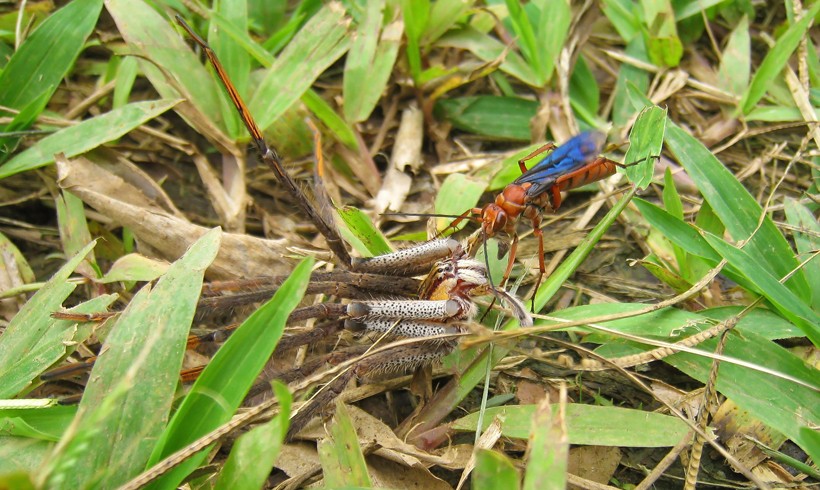
Tarantula hawk dragging the living, paralyzed spider to the burrow, Costa Rica
?
Image credits: Vilainecrevette/Shutterstock
Once the egg hatches, the tiny hawk larva pierces and enters the abdomen of the still living paralyzed tarantula. The larva continuously feeds on the still living spider, till it grows into a full-size wasp. Amazingly but cruelly, the larva avoids the vital organs of the spider in order to keep it alive for as long as possible. After approximately three weeks, the larva emerges out from the dead tarantula’s body as a fully grown wasp. The mature males and females live for up to 2 months and reproduce as quickly as possible. The tarantula hawk’s lifecycle and their effective method of reproduction, allow the larva to become a fully grown wasp without being eaten by predators.
Behavior and Communication
The tarantula hawk is a diurnal creature that spends the day in search of nectar and fermented fruits. However, due to the nocturnal lifestyle of the tarantulas, hunting usually occurs at dusk. The wasps are usually calm and do not attack humans unless their life is in danger. Tarantula hawks do not live in colonies like most wasps, ants and bees of the hymenopterans order; instead, they prefer a solitary lifestyle. Their capability of strategically luring out and hunting down large tarantulas clearly indicates that the tarantula hawk is quite smart and efficient.
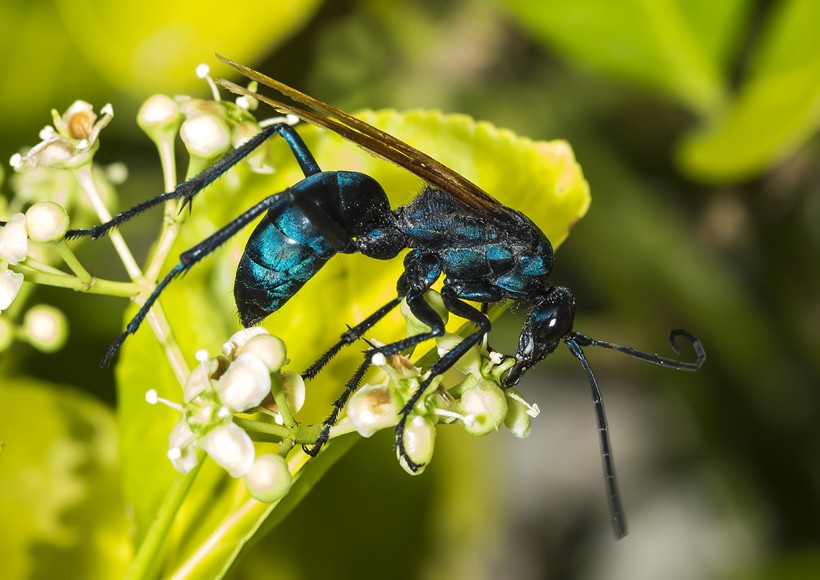
The tarantula hawk is a diurnal creature that spends the day in search of nectar and fermented fruits.
?
Image credits: Elizabeth A.Cummings/Shutterstock
Population
Tarantula hawks exist worldwide (mostly in the tropics and southern hemisphere) due to their adaptable nature. However, their survival is directly dependent on the population of tarantulas. Tarantulas are popular as pets in many countries; as a result of which these spiders are captured in large numbers. Even a larger number of tarantulas get killed during the capture process. In many countries, these spiders form a part of local cuisines. On the other hand, there are hundreds of species of tarantula hawks that hunt tarantula spiders to lay their eggs on them.
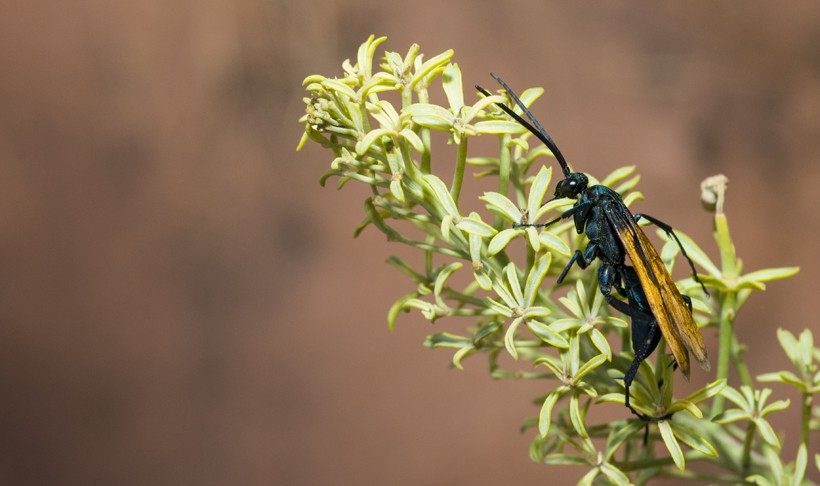
Tarantula hawks exist worldwide (mostly in the tropics and southern hemisphere) due to their adaptable nature.
?
Image credits: NatalieJean/Shutterstock
Though the populations of both tarantulas and tarantula hawks are rising at the moment, the rapid growth of human population and occupation can act as a serious threat to these creatures in near future.
Evolution
Tarantula hawks belong to the family Pompilidae of the order Hymenoptera. The earliest species of the order hymenoptera came into existence during the Triassic period. The earliest fossils found are of sawflies from the Xyelidae family. Social hymenopterans like bees, ants and wasps arrived during the late Cretaceous period. These hymenopterans lived in colonies consisting of hundreds of individuals.

The 250-300 species of tarantula hawk are divided in genera Pepsis and Hemipepsis of family Pompilidae
?
Image credits: Adam Overbey/Shutterstock
The evolution of spider wasps of the family Pompilidae could be the result of rapid evolution. Rapid evolution occurs when a creature changes fast its behavior to adjust to the rapidly changing environment. Researchers speculate that the tribe of wasps might have shifted to tarantula hunting as a defensive strategy to survive rapid environmental changes during the Cretaceous period. The evolutionary factor responsible for their enormously painful stings can be their necessity to take down the larger and stronger tarantulas.
Funfacts
- Spider wasps are the largest of all wasps, with some species growing up to 5 cm in length.
- There are hundreds of species of tarantula hawks and their population is distributed worldwide.
- Their sting is considered as one of the most painful ones. Only bullet ants have a more painful sting.
- All species of spider wasps hunt on tarantulas and other large spiders.
- The tarantula hawk also hunts the largest of all tarantulas, the goliath bird-eating spider. These spiders have a leg span of 30 cm and are capable of hunting small birds, but are often subdued by the 5 cm long wasp.
- The wasp was chosen as the State Insect of New Mexico, by the 39th legislature in 1989.
- The tarantula hawk sting can be very painful but it is not actually harmful to humans. No medical attention is required and the effects last for only a few days.
